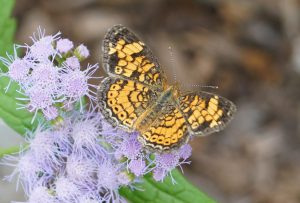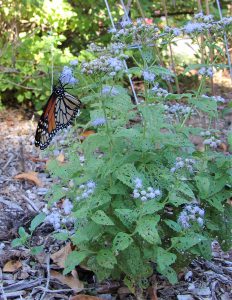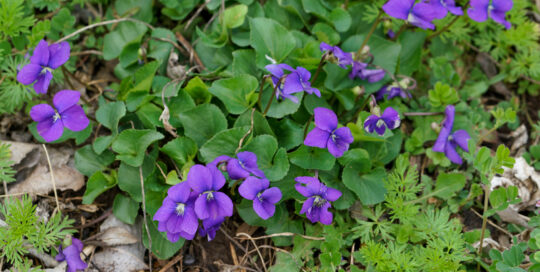Plant profile: mistflower
Views: 1740

It has been a wet winter here, and I now have more than enough information to identify where the soggy parts of my yard are, and where I need to locate a future rain garden. NOAA is predicting a damp spring for us, as well, so it’s a good opportunity to try to establish some plants that do well in moist soil. One that I love from past experience is a southeastern native, Mistflower, Conoclinium coelestinum, also known as Blue Mistflower, Blue Boneset, Hardy Ageratum, and Wild Ageratum. Though is it no longer classified in the Eupatorium (Boneset) genus, it is closely related, and it is still referred to as Eupatorium coelestinum on many websites.
Where to find Mistflower
I first encountered Mistflower along the edges of my former pond, growing wild. This was, of course, its native habitat, growing near water in rich soil. It was covered in bees and butterflies, despite being in dappled shade. Anything that blooms in part shade and attracts pollinators is a treasure to me, so I transplanted one flower into a shady spot in a flowerbed, not knowing if it would survive sandy soil and summer drought.
Much to my surprise, not only did it survive the change in moisture and soil, it spread quickly to form a lovely clump. I know now that Mistflower is fairly tolerant of many types of soil including sand and clay, and it spreads by rhizomes and seeds. In some areas it spreads so well it is considered weedy. But it is a great plant for damp, full sun to part shade where it has room to spread. It is well-suited to rain gardens.

Mistflower attracts a variety of pollinators to part shade. It is also a host plant to a few species of moth.
Growing Mistflower
In my poor soil, it only reached about 12-14 inches tall. In ideal situations, it can reach up to four feet. While it survived a very hot and dry summer in my yard, it did need regular watering. I recommend planting Mistflower somewhere where you can easily water or regularly irrigate it. That said, I think this is a pretty hardy plant, so it is worth trying in any situation you want a pollinator-attracting flower that is not in full shade.
Any pollinator that frequents Bonesets will also visit Mistflower. These include many butterflies and long-tongued bees. I often saw sweat bees and skippers on mine. My plants looked ragged by summer because something ate them. It is a host plant for various moths, although I never found any caterpillars. (I hoped that the birds ate the caterpillars.) Mistflower is usually not bothered by deer.
Mistflower is available from nurseries, particularly those specializing in native plants. Look for it under both Conoclinium coelestinum and Eupatorium coelestinum. You can also propagate it from seed. I recommend sowing the seeds in the fall, or exposing them to cold, moist stratification in a refrigerator for three months. I was lucky enough to find it in a nearby nursery, so I’m looking forward to enjoying this plant when it blooms this summer and fall.
Meet Leslie Miller
Leslie Ann Miller shares 3.5 acres in rural Oklahoma with birds, butterflies and wide variety of animals. She is currently transforming her yard with plantings…
Leslie's Recent Posts

Early spring is time to plant native spring ephemerals






